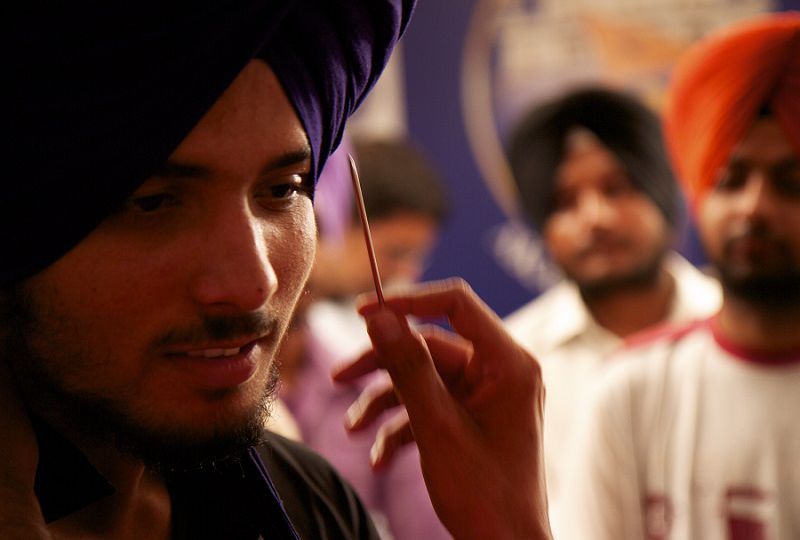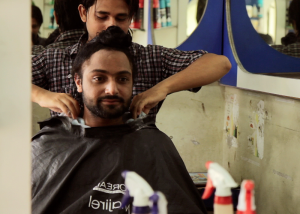
In 2009, I was conducting doctoral research in Chandigarh (the capital of the Indian state of Punjab), interviewing young migrant men from across the region. As I was talking to them about their future aspirations and desire to be part of the transnational migration complex[1] that now defines what it means to be a successful Punjabi man, I came across a set of curious cultural phenomena. Most of the young Sardars (turban-wearing Sikh men) I met and spoke to had cut their previously unshorn hair within months, if not weeks of arriving in Chandigarh.
For many aspiring migrants, Chandigarh represents an in-between place, a “knowledge society”[2] of sorts, where young men can acquire the educational and vocational skills they need to qualify for a study-abroad or work visa. Furthermore, even after forgoing their unshorn hair, these men and other returning migrants (colloquially referred to as Non-Resident Indians or NRIs) would continue wearing their turbans, especially when travelling through Chandigarh and while visiting their families across rural Punjab. I was puzzled by this revelation that a mona Sikh (colloquially referred to as a ‘cut Surd’ or a shorn Sardar) would choose to continue wearing a turban.
While the Sikh scriptures sternly denounce the cutting of hair, this practice has grown increasingly common, and by some unofficial estimates, over 75% of Sikh men cut off their hair. Despite its denunciation within orthodox families and communities, Sikh men who cut their hair are rarely denied their claims to their religious identity, and most continue practising Sikhism, observing all other aspects and teachings of the religion.
The significance of the turban within Sikhism and in the formation of Sikh identity has been a topic of ongoing debate among historians and scholars of Sikh studies. Some refer to it as the most important symbol of identity, while others call it an antiquated head-covering meant to protect kesh (unshorn hair), the more genuine (albeit hidden) symbol of Sikh identity. In religious and cultural debates and representations of the Sikh turban, this symbolic object rarely appears disassociated from its counterpart, kesh. I had assumed up until I started my research that most Sikh men who cut their hair simultaneously give up wearing turbans altogether.
As I have documented in my 2010 documentary film Roots of Love, reasons for cutting unshorn hair vary widely. However, over the last decade and a half, as transnational migration becomes an aspiration for the majority of families across rural Punjab, the fear of being discriminated against by foreign immigration officials, as well as the fear of being subjected to racism, xenophobia and hate crimes upon arriving on foreign shores[3] seems to dominate the list of justifications Sikh migrants offer for preemptively cutting their hair.
Secondary to that are often more practical concerns about the desire to “save time” and adjust to the “busy pace of life” that awaits them upon arriving in countries like Canada or the United States, where labour migrants often quantify their working hours in strictly monetary terms.
So, in this sense, if the turban-tying ceremony represents the official rite of passage from Punjabi/Sikh boyhood into Punjabi/Sikh manhood, the practice of cutting unshorn hair upon arriving in Chandigarh signifies yet another (albeit unofficial) rite of passage from Punjabi/Sikh manhood into migrant manhood – a physical transformation of sorts necessary to become a successful transnational migrant.
Given this ongoing cultural shift, anxious religious leaders and Sikh organisations across Punjab and in the diaspora have led concerted campaigns to counteract the misconceptions associated with the turban and encourage young men to retain their unshorn hair or readopt the turban as a symbol of their identity. While well-intentioned, the cumulative effect of such interventions can be reduced to further obsession with and glorification of the Sikh turban – a sole masculinist religious symbol, at the risk of overlooking and sidelining more pressing concerns confronting the Sikh community including issues of gender and caste inequality rooted in heteronormative, patriarchal, elitist traditions and cultural practices in Punjab.
Circling back to my observations in the opening of this article, while the choice to forgo their unshorn hair in anticipation of transnational mobility seems intuitive, how do we make sense of the more ambiguous cultural practice of these men choosing to wear their turbans after having cut their formerly unshorn hair, while walking around Sector 17 market (a popular spot in Chandigarh), or hanging out at Punjab University’s student union, or cursing in a jeep or on a Bullet motorcycle riding down Chandigarh’s infamous gerdi (a colloquial term for cruising) route? Why would an NRI tie a turban before getting on the plane headed back home to Punjab (something I have documented on several occasions during my flights to India)?
I do not believe that these men are trying to pass as keshdhari (‘full’ or unshorn) Sikhs. Instead, I regard their behaviour as something along the lines of ‘covering’ or downplaying their transgression, as cutting unshorn hair is often considered shameful in very devout Sikh families and religious communities. Rather than the deceptive quality that ‘passing’ (the ability to be regarded as a member of an identity group one is not a part of) entails, ‘covering’, as Kenji Yoshino explains[4], is the deliberate toning down of aspects of disfavoured identity to fit into the status quo.
While family members and religious groups do have a sway on these men’s behaviours, I suspect that their choice to don this particular accessory has less to do with their religiosity, and is more about reproducing a particular heterosexual affect, performing a particular form of exaggerated masculinity, and signaling a particular upper caste/class status that is intelligible within the regional context and cultural milieu.
Given the historical and cultural investment in the turban as a marker of Sikh masculinity, transnational Sikh migrants continue wearing turbans (though intermittently) even after cutting their hair because in addition to identifying them as belonging to Sikh families, their turbans also identify them as hypermasculine, hypersexual, and belonging to the landowning (Jat) caste. This is evidenced by the most common explanation that I have documented to my question, “Why are you wearing a turban even though you’ve cut your hair (and no longer need to)?” Inevitably, my interviewees insist: “Personality bandi hai (It adds to my persona), sir!”
As scholars like Radhika Chopra[5] and Virinder Kalra[6] have pointed out, because of their preferential treatment within the colonial regime and their prominence within the Indian Army, Punjabi Sikh men have historically represented the exemplar masculinity against which other Indian masculinities were often contrasted. Even though after the events of 9/11/2001 the turban came to represent terrorist monstrosity in the North American cultural imagination[7], over the last decade in Indian popular cultural imagination, the turban has undergone a resurgence of sorts.
Turbaned men seem to be featured prominently in popular culture – in Bollywood films like Singh is Kinng, Rocket Singh – Salesman of the Year, Bhaag Milkha Bhaag, and across regional Punjabi cinema, especially with the recent popularity of singer-turned-actor Diljit Dosanjh (featured in the video above) who has made a career out of highlighting his signature turban (though several unnamed sources who have worked closely with Dosanjh claim that he too has a trimmed head of hair underneath his turban).
While turbaned Sikh men have frequently appeared as objects of orientalist fetish and desire in Western literature and cinema (Michael Ondaatje’s The English Patient, the novel and film, for example), more recently, this trope of the hypermasculine, hypersexualised turbaned Sikh man has also appeared in diasporic literature (see A.X. Ahmad’s The Ranjit Singh Trilogy).
Despite the varied circulations, different intended audiences, and localised contexts through which popular representations of turbaned Sikh men are rendered intelligible, they all seem to share one feature in common: they privilege a form of (hetero)sexuality that is based entirely on the physical attributes of masculine embodiment – celebrating the brawny prowess, muscular physique, and rough, rugged brashness associated with turban-wearing male bodies.
Given this complex history of the Sikh turban and the layers of historical and cultural significance and ongoing meaning this symbol represents, it is hardly a surprise that Punjabi Sikh migrants hang on to their turbans long after cutting their hair. While the act of forgoing their hair allows them to transition into a type of embodiment necessary for transnational migration and mobility, wearing their turban allows them to claim belonging within Punjab and continue enjoying gendered and caste-based privileges that accompany being a turbaned Sikh man in India.
Unhinged from its traditional counterpart – the unshorn hair it has historically been burdened with covering – the turban for many Sikh migrants in the 21st century transnational/global context represents what anthropologist Aihwa Ong would classify as a symbol of “flexible citizenship”[8]; that which can be worn and unworn depending on the place, cultural environment, and direction of the journey.
As one such ‘cut Surd’ migrant wearing a meticulously tied peach-coloured turban proclaimed at the end of his interview, “After cutting the hair, I can do everything now! Everything!!”
[1] This term refers to the ongoing history of labour migration from Punjab to Europe, North America, Australia, and more recently, the Gulf, motivated by the desire to seek better economic prospects and a more financially secure future.
[2] Nisbett, Nicholas. 2009. Growing Up in the Knowledge Society: Living the IT Dream in Bangalore. New Delhi: Routledge.
[3] Grewal, Inderpal. 2013. ‘Racial Sovereignty and ‘Shooter’ Violence: Oak Creek Massacre, Normative Citizenship, and the State’. Sikh Formations, 9(2): 187-197.
[4] Yoshino, Kenji. 2006. Covering: The Hidden Assault on Our Civil Rights. New York: Random House.
[5] Chopra, Radhika. 2010. Militant and Migrant: The Politics and Social History of Punjab. London: Routledge.
[6] Kalra, Virinder. 2005. ‘Locating the Sikh Pagh’. Sikh Formations, 1(1): 75-92.
[7] Puar, Jasbir. 2008. ‘The Turban is Not a Hat: Queer Diaspora and the Practices of Profiling’. Sikh Formations, 4(1): 47-91.
[8] Ong, Aihwa. 1999. Flexible Citizenship: The Cultural Logics of Transnationality. Durham: Duke University Press.
All images are courtesy of the author.
